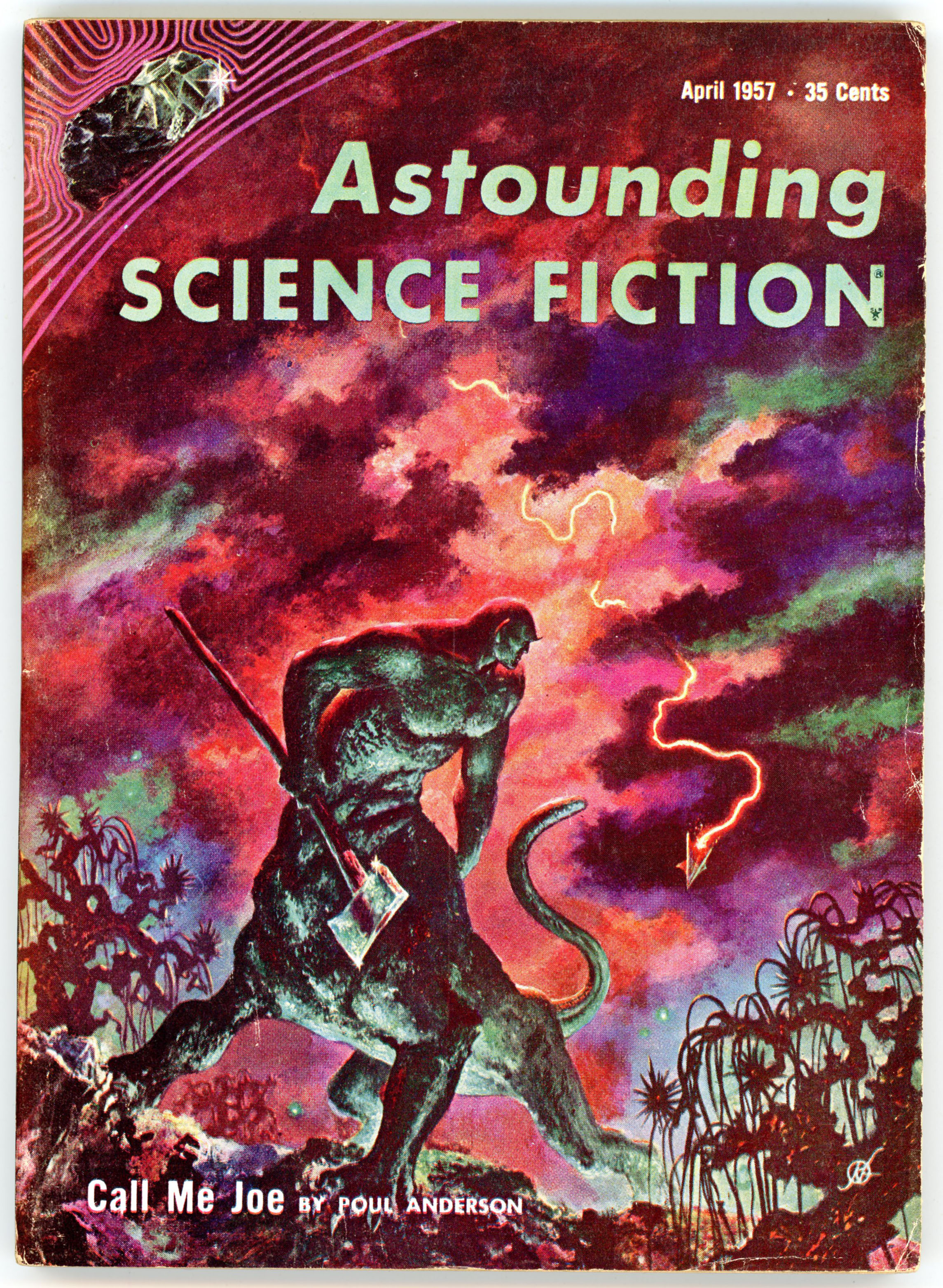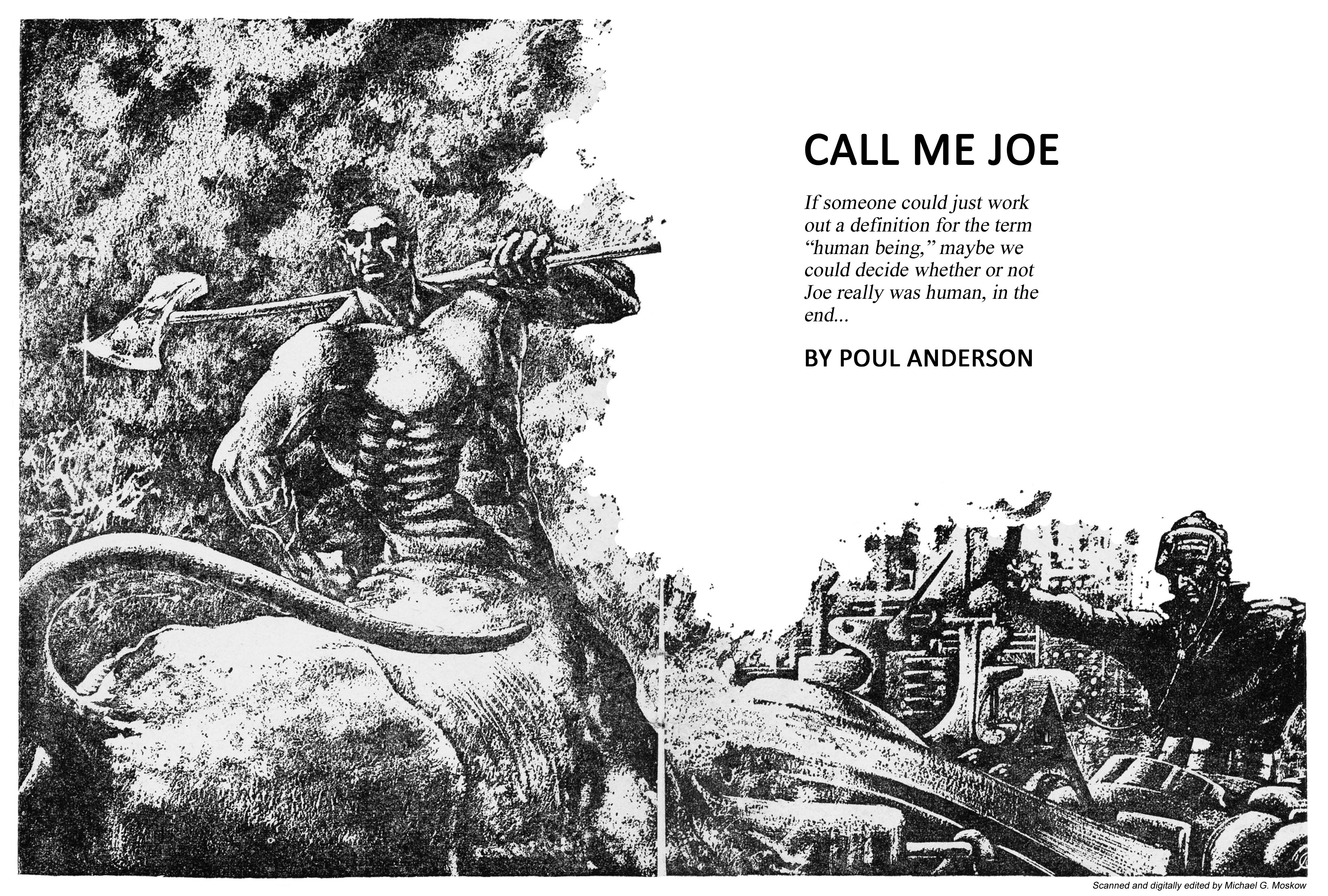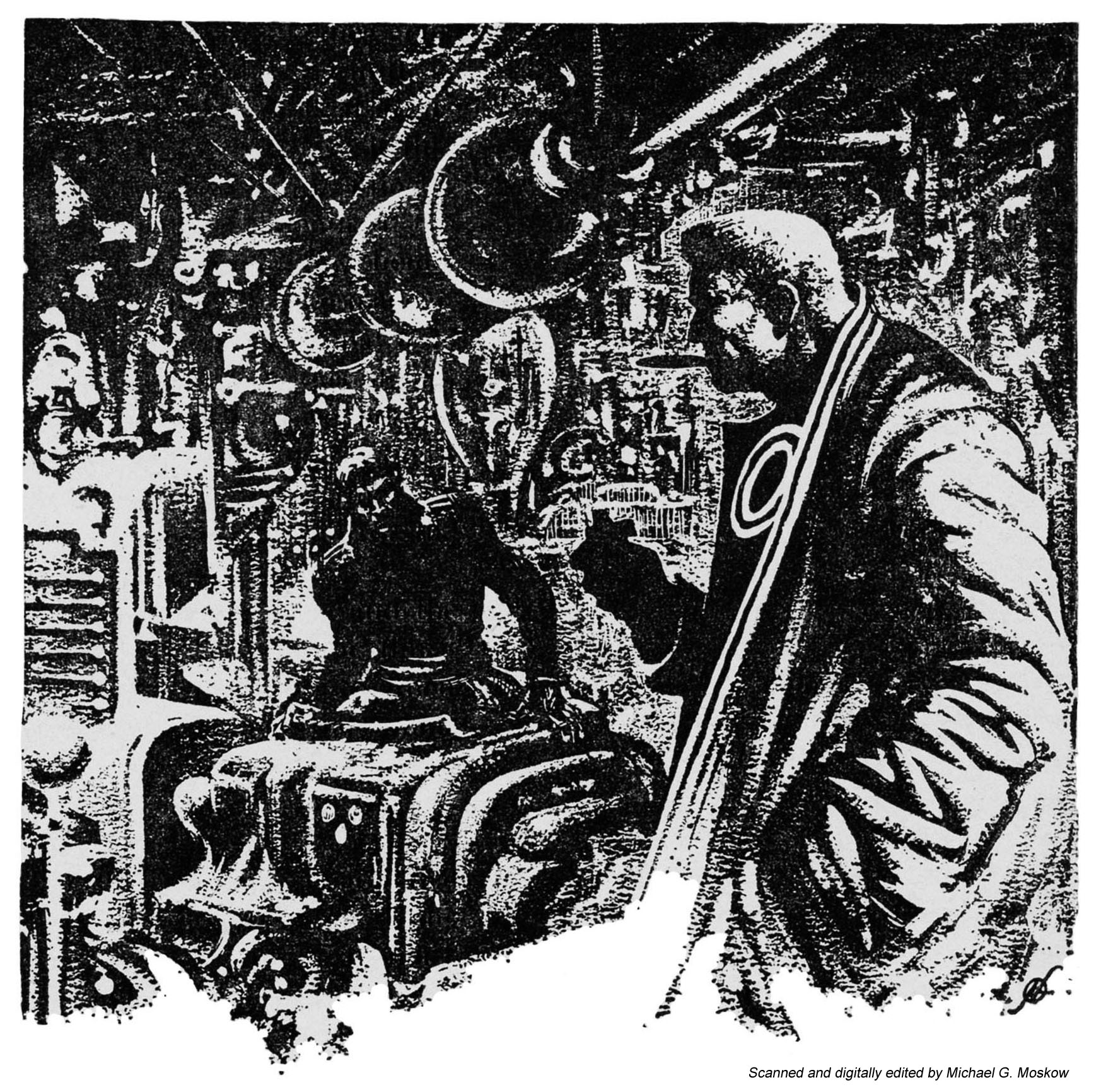“Joe roared.”
“Imagine being strong!”
The cover art for Astounding Science Fiction for April of 1957 represented the 19th such illustration for that magazine created by Frank Kelly Freas, his first cover art having been an allegorical illustration for the story The Gulf Between, in the magazine’s March, 1954 issue. Portraying Poul Anderson’s story “Call Me Joe”, Freas’ painting – and his accompanying interior art – fits the scenes, mood, technology (at least, what few technological descriptions there are!), and science (at least, science of the future) marvelously.
Freas’ use of shades of violet, orange, red, and brown for the Jovian sky, in combination with greens and blues for the the planet’s surface and vegetation – finished with a yellowish-red exhaust / re-entry trail for a descending spacecraft – lend an almost iridescent quality to the image.
Of course, you can’t overlook Joe, himself: the metallic green centaur-like creature – a genetically engineered being – silhouetted against the glowing sky, who is a – but not solely “the” – center of the story.
In any event, I’m under the impression that – akin to Arthur C. Clarke’s The Sentinel, which formed a plot element of, but was not the sole and central basis for 2001: A Space Odyssey, Poul Anderson’s story was, to lesser or greater degree, part of the inspiration for James’s Cameron’s 2009 film “Avatar”. (That’ll require some clarification via DuckDuckGo.)
If so – and I think this is so – this would have done a great disservice to the depth, profundity, and originality of Anderson’s story, which is actually an exploration of concepts of identity, individuality, and personality, as well as – to a lesser extent – the ethics and morality surrounding the creation of artificial, sentient life. An example of the latter being “Joe”, on the cover. Another interesting feature of the tale is Anderson’s conception of a temperamental electronic device known as a “K-tube”, which enables real-time telepathic communication between controller Ed Anglesey, and receiver / test subject, “Joe”.
You can read a very nice summary of the story at Wikipedia.
This is unlike Cameron’s film, which – though it has elements and stereotypical tropes of science fiction – (well, hey, oh wow – it’s got fancy technology) is not a work of science fiction, and I think was never intended to be so. Quite the opposite.
“Avatar” is best understood as less science-fiction, and vastly more as an exercise in virtue signalling (to the tune of $237,000,000), by which the technocratic / meritocratic elite of 21st Century Western Civilization – the “ruling class” – validates its ever-uncertain social status, and, affirms its intellectual superiority, moral virtuosity, and spiritual refinement.
(That is, of course, in its own eyes.)
But, that’s for another discussion.
Enough, with the politics.
(For now.)
I hope you enjoy Kelly Freas’ art, and excerpts from Poul Anderson’s text. The symbol in the upper left corner is typical of the cover design of late-1950s issues of Astounding, which featured symbolic or literal representations of objects and concepts having a scientific theme. In this case, “Transformation under heat and pressure.”
_____________________
For a moment, then, he knew only a crazy smothering wave of panic.
He thought he was back on Earth Station,
floating in null-gee at the end of a cable
while a thousand frosty stars haloed the planet before him.
He thought the great I-beam had broken from its moorings and started toward him,
slowly,
but with all the inertia of its cold tons, spinning and shimmering in the Earthlight,
and the only sound himself screaming and screaming in his helmet
trying to break from the cable the beam nudged him ever so gently
but it kept on moving he moved with it
he was crushed against the station wall nuzzled into it
his mangled suit frothed as it tried to seal its wounded self
there was blood mingled with the foam his blood
Joe roared. (p. 17)
_____________________
_________________________
“Imagine walking under a glowing violet sky,
where great flashing clouds sweep the earth
with shadow and rain strikes beneath them.
Imagine walking on the slopes of a mountain like polished metal,
with a clean red flame exploding above you and thunder laughing in the ground.
Imagine a cool wild stream,
and low trees with dark coppery flowers,
and a waterfall, methane-fall … whatever you like … leaping off a cliff,
and the strong live wind shakes its mane full of rainbows!
Imagine a whole forest, dark and breathing,
and here and there you glimpse a pale-red wavering will-o’-the-wisp,
which is the life radiation of some fleet shy animal, and … and – ”
Anglesey croaked into silence.
He stared down at his clenched fists,
then he closed his eyes tight and tears ran out between the lids.
“Imagine being strong!” (p. 26)
_____________________
_____________________
“So.
That’s all there is?
You thought I was afraid to come down here and be Joe,
and wanted to know why?
But I told you I wasn’t!”
I should have believed – whispered Cornelius.
“Well, get out of the circuit then.”
Joe continued growling it vocally.
“And don’t ever come back in the control room, understand?
K-tubes or no, I don’t want to see you again.
And I may be a cripple, but I can still take you apart cell by cell.
Now – sign off – leave me alone.
The first ship will be landing in minutes.”
You a cripple … you, Joe Angelsey?
“What?”
The great gray being on the hill lifted his barbaric head as if so sudden trumpets.
“What do you mean?”
Don’t you understand? said the weak, dragging thought.
You know how the esprojector works.
You know I could have probed Angelsey’s mind in Angelsey’s brain
without making enough interference to be noticed.
And I could not have probed a wholly nonhuman mind at all,
now could it have been aware of me.
The filters would not have passed such a signal.
Yet you felt me in the first fractional second.
It can only mean a human mind in a nonhuman brain.
You are not he half-corpse on Jupiter V any longer.
You’re Joe – Joe Angelsey.
“Well, I’ll be damned,” said Joe. “You’re right.” (p. 37)
– Poul Anderson –




